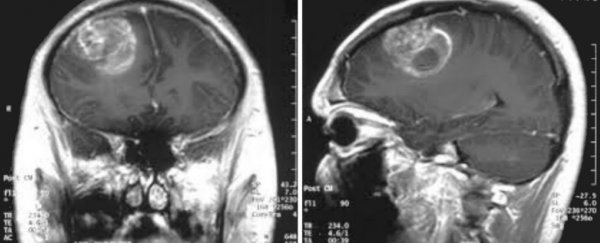Researchers have found that when combined with anticoagulant drugs, antidepressants can slow the growth of aggressive brain tumours called gliomas, causing the cancer cells to effectively eat themselves and stem the progression of this particularly deadly disease.
Stemming from the brain's glial cells - which help to support and insulate the neurons - gliomas make up about a third of all brain tumours, and hold the highest mortality rate among brain cancer patients, with little by way of treatment available. While this new drug combination has so far only been tested on mice, it ended up doubling their lifespans, and researchers are now investigating if it could increase the survival period for human glioma patients.
"It is exciting to envision that combining two relatively inexpensive and non-toxic classes of generic drugs holds promise to make a difference in the treatment of patients with lethal brain cancer," one of the researchers, Douglas Hanahan from the Swiss Federal Institute of Technology, said in a press release.
A specific class of antidepressants called tricyclic antidepressants have shown promise as a possible treatment for gliomas, but it wasn't until Hanahan and his team thought to combined then with the anticoagulant drug, ticlopidine, that the effects become clear. They gave this "seemingly innocuous combination" to lab mice with gliomas - the antidepressant was taken orally and 10-15 minutes later the anticoagulant was injected - for five consecutive days.
The team found that this 'combination therapy' messes with a particular pathway in the brain that controls a mechanism in glial cells known as autophagy - which means "to eat oneself". While this mechanism is usually perfectly harmless, and actually cleans up degraded cell parts to make way for newer, healthier ones, the two drugs put it into overdrive, prompting it to destroy cells in their entirety.
While either drug can kick-start the process of autophagy on its own, previous tests have shown that this wasn't enough to stem the progression of glioma, which occurs when the production of glial cells gets dangerously out of control. Hanahan and his team found that only when they're used together can they induce such a strong reaction, and the mice that were treated with both drugs ended up living twice as long as those that weren't.
The results have been published in Cancer Cell.
The researchers are careful to point out that not only has this not been tested on humans yet, it also didn't cure gliomas in the mice they worked with. Rather, by slowing down the progression of the disease, it gave the mice a significantly longer lifespan, which is better than nothing when you're dealing with a lethal disease.
"It seems likely that these drugs will need to be combined with other classes of anticancer drugs to have benefit in treating gliblastoma patients," Hanahan told Hannah Osborne from International Business Times. "One can also envision 'co- clinical trials' wherein experimental therapeutic trials in the mouse models of glioblastom are linked to analogous small proof-of-concept trials in GBM patients. Such trials may not be far off."
